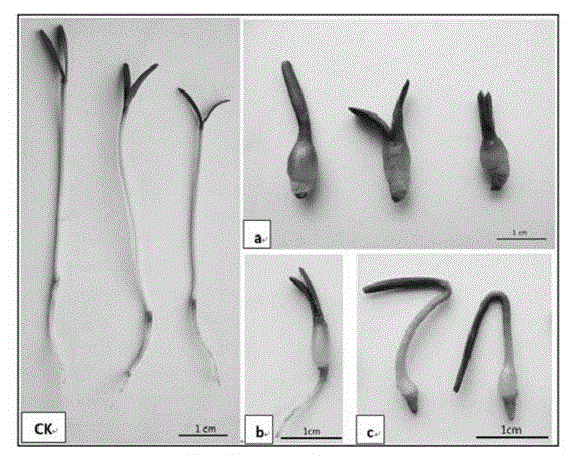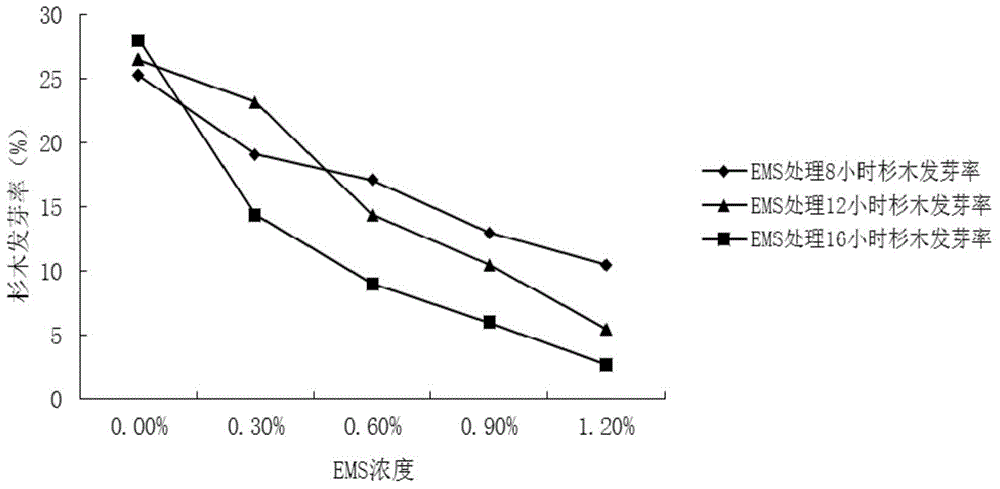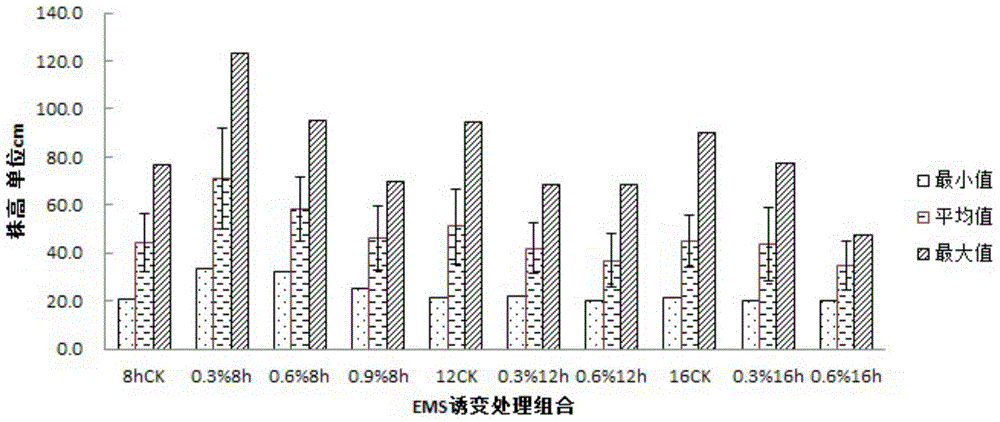Mutation breeding method for cunninghamia lanceolata
A technology of Chinese fir and seeds, applied in the field of mutation breeding of Chinese fir
- Summary
- Abstract
- Description
- Claims
- Application Information
AI Technical Summary
Problems solved by technology
Method used
Image
Examples
Embodiment 1
[0100] Example 1 Colchicine mutagenesis treatment
[0101] 1. Seed source
[0102] In November 2011, the mature cones of Chinese fir were collected in the seed garden of the state-owned forest farm in Jiangle County, Fujian Province, and the dried seeds were collected and then refrigerated at 4°C for 3 months. As the mutagenic seed material in this experiment.
[0103] 2. Gibberellin soaking treatment
[0104] This study started in February 2012, and in February, the low-temperature treated seeds were soaked in gibberellin.
[0105] 2-1 Under the condition of constant room temperature (25±5°C, 25°C is selected in the embodiment of the present invention), first soak the dry seeds of Chinese fir in a gibberellin solution with a concentration of 25mg / L, after soaking for 24h, wash with distilled water Seed 5 times, remove gibberellin residual liquid on the surface of Chinese fir seed, obtain gibberellin seed soaking treatment seed.
[0106] Soak the seeds to improve seed germ...
Embodiment 2
[0124] Example 2 Ethyl methanesulfonate (EMS) mutagenesis treatment of Chinese fir seeds
[0125] 1. Seed source
[0126] Same as "seed source" in embodiment 1.
[0127] 2. Gibberellin soaking treatment
[0128] Same as "Gibberellin Soaking Treatment" in Example 1.
[0129] 3. Soaking in distilled water
[0130] Same as "distilled water immersion treatment" in embodiment 1.
[0131] 4. Mutagenesis treatment
[0132] Under the conditions of room temperature (25±5° C.) and completely protected from light (that is, darkness), the Chinese fir seeds soaked in distilled water were subjected to EMS mutagenesis treatment.
[0133] The test set 4 concentration gradients (0.3%, 0.6%, 0.9%, 1.2% w / v), 3 treatment times (8h, 12h, 16h), wherein the preparation method of EMS solution is to dissolve EMS in pH=7.0, 0.1mol / L phosphate buffer. That is to say, 0.3g, 0.6g, 0.9g, and 1.2g EMS are respectively dissolved in 100mL of pH=7.0, and 0.1mol / L phosphate buffer is made into the EMS m...
Embodiment 3
[0143] Example 3 Sodium azide (NaN 3 ) mutagenesis treatment of Chinese fir seeds
[0144] 1. Source of seeds:
[0145] Same as "seed source" in embodiment 1.
[0146] 2. Gibberellin soaking treatment
[0147] Same as "Gibberellin Soaking Treatment" in Example 1.
[0148] 3. Soaking in distilled water
[0149] Same as "distilled water immersion treatment" in embodiment 1.
[0150] 4. Mutagenesis treatment
[0151] Under the conditions of room temperature (25±5°C) and completely protected from light (that is, darkness), the Chinese fir seeds soaked in distilled water were subjected to sodium azide mutagenesis treatment.
[0152] Five concentration gradients (2, 4, 6, 8, 10mmol / L, prepared with pH=3.0, 0.1mol / L phosphate buffer) were set in the experiment, and the gibberellin soaked seeds were respectively soaked in sodium azide solution In 25°C, shake (120 rpm) for 4h, 8h, and 12h, and then wash the mutagenized seeds under running water for 2h to remove the residual sodi...
PUM
 Login to View More
Login to View More Abstract
Description
Claims
Application Information
 Login to View More
Login to View More - R&D
- Intellectual Property
- Life Sciences
- Materials
- Tech Scout
- Unparalleled Data Quality
- Higher Quality Content
- 60% Fewer Hallucinations
Browse by: Latest US Patents, China's latest patents, Technical Efficacy Thesaurus, Application Domain, Technology Topic, Popular Technical Reports.
© 2025 PatSnap. All rights reserved.Legal|Privacy policy|Modern Slavery Act Transparency Statement|Sitemap|About US| Contact US: help@patsnap.com



